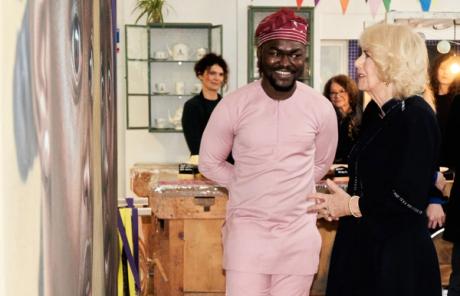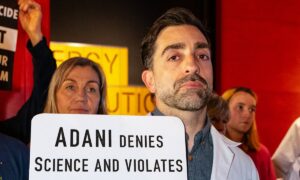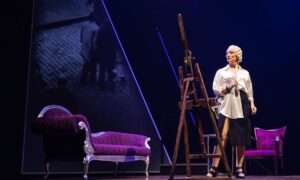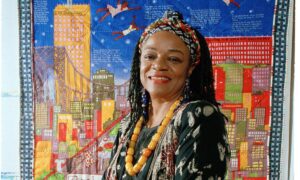
The UK’s Queen Camilla this week made a Valentine’s Day visit to Kindred Studios, west London, a creative home for artists and makers that offers affordable rents to makers ranging from fine artists to ceramicists, fabric makers and furniture restorers. It also provides mentoring and artist demonstrations to school groups and parents, and bursaries to young creatives.The charity—whose hub in the Shepherd’s Bush area is home to nearly 70 artists, who pay as little at £250 a month in rent for studio space—is in its third location since its foundation in 2015 and is now looking for a permanent site. In each of its three London bases to date it has depended on receiving short-term space at a peppercorn rent from landlords or developers looking for temporary occupants. “We would love to work with developers and evolve an artists’ [permanent] live-work space,” Kindred’s founder, Angelique Schmitt, told The Art Newspaper.The Queen, along , with her stepson the Prince of Wales, has been the subject of close attention since the British monarch King Charles III stepped back from public duties on 5 February, while he undergoes treatment for cancer. The performance art of monarchyThe Queen’s keeping up of public duties is a continuum of the art of monarchy demonstrated by her late mother-in-law Queen Elizabeth II over seven decades, as part of which the monarch and their spouse have above all to be seen and present to the public. Part of the performance of that art is to be on time—the Queen duly arrived at the studios on the dot with a retinue including a lady-in-waiting, a uniformed military equerry, and detectives. Another is being balanced in the giving of time and attention, ensuring everyone who is met is taken seriously and clearly “seen”. It thus becomes a kind of performance art not unlike a multi-locational version of Marina Abramović’s The Artist is Present (2010)—for which Abramović sat in place for three months, eight hours a day, while a succession of visitors to the Museum of Modern Art, New York, came to sit opposite her—and no less demanding.Queen Camilla is patron of a number of arts bodies and charities, including the Royal School of Needlework and the Royal Society of Literature, and has since 2006 been president of the Ditchling Museum of Art + Craft in Sussex. Charles III has a long history in the encouragement of training in art and architecture—notably as founder in 2000 of the Royal Drawing School (previously the Prince’s Drawing School)—and is additionally as proprietor in trust of the Royal Collection, one of the world’s greatest art collections.The Queen with the artist Jon Rees (right) and the artist Angelique Schmitt, who is the founder and director of Kindred Studios Lily Bertrand WebbFace to face with art and artistsThe Queen had come to see Kindred Studios’ hub, as she told artists during her tour of individual studios and communal areas, at the recommendation of her daughter Laura Lopes, who had visited recently and been much impressed by the project.One of her first conversations was in front of a courtyard mural with the artist Jon Rees, who had previously lived in the building when it was a homeless charity run by the charity St Mungo’s, and now acts as a mentor to young artists at Kindred. After visiting four further artists in their studios—including the abstract artist Michèle Jaffé-Pearce, with whom she discussed the relative challenges of working in oils and watercolours—the Queen returned to the courtyard, and a light February drizzle, to be regaled with folk singing by a Bulgarian choir who use the centre for their rehearsals.In the main entrance to the centre she met the Nigerian artist Babajide Olatunji, who showed her a recent oversize photorealistic double portrait on canvas she had produced. The Queen also examined the miniaturised vitrine art of the artist Cordelia Plunket, who uses ethically sourced, taxidermied bird cadavers to recreate significant existing works of art and cultural events. Plunket’s State of Mind, a small-scale remake of Tracy Emin’s Bed (1998), was closely inspected and the Queen showed instant familiarity with the iconography of the cover of the Beatles’ Abbey Road (1969) when advancing on Plunket’s miniaturised take on that scene.The Queen (centre front) with a group of artists at the conclusion of her visit to Kindred Studios Lily Bertrand WebbThe benefit of communityThe challenge of finding cheap, permanent, working spaces for artists is a perennial problem in global cities such as London, Paris and New York. One solution in London has been to find “meanwhile spaces” provided by commercial landlords or local authorities during a “fallow” period for a building while it awaits demolition or redevelopment. This has been the model pursued by Kindred to date. (Last November, V.O Curations, another non-profit arts organisation that provides low-cost studio spaces to artists, was asked to vacate short-lease premises near Tower Bridge, and was able to give artists two months’ notice.)Schmitt wants to move Kindred away from this “meanwhile” and find it a permanent home, ideally in London. The charity, she says, has been fundraising in preparation for finding a permanent base with a developer partner who sees the benefit of an artist live-work model to a local community. Those benefits, she says, are not in doubt. Kindred’s London centres have invited teachers and parents to bring children to offer them the rare chance to “see how things are made and what an artist does.” And then there is the communal support offered artist-to-artist. Kindred artists are expected in return to offer guidance and advice to the local community, notably through biannual open days. One of the Kindred artists ran a photography therapy course for NHS doctors exhausted by their role in dealing with the Covid-19 global pandemic. “Goodwill is an important part of this project,” Schmitt says.In the days after the Queen’s visit, Kindred posted on social media about the closing of Crafts Central, a space for artists’ studios in east London. Crafts Central has cited the “effects of the Covid-19 pandemic, rising costs, particularly utility bills, and a decline in funding for arts and crafts in the UK” as reasons for ceasing trading at the end of this month.“So now more than ever, councils and the powers that be need to pay attention,” Kindred says on Instagram. “The days of incredible artists in London working from derelict buildings and producing not just amazing work but art movements have gone… but we can’t loose sight of just how important it is to nurture creativity not just as a career but the impact it has socially to a community.”The power of drawing attentionThe community aspect of Kindred Studios was emphasised again at the end of the royal visit, when the Queen met a large group of additional artists and community members privately, once the “royal rota”—the press pool given permission to access royal events—had left the scene.The Queen’s visit, as Schmitt said on Instagram, had put a “spotlight on the benefits of creatives working together”. It had also demonstrated another aspect of the art of monarchy: the power to draw attention to good causes, whether they be social, communal, artistic or, as in the case with Kindred Studios, all three combined.


























